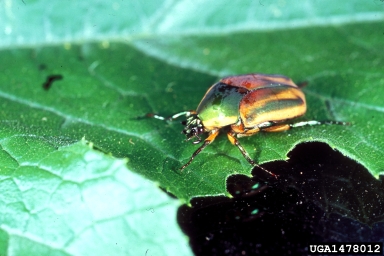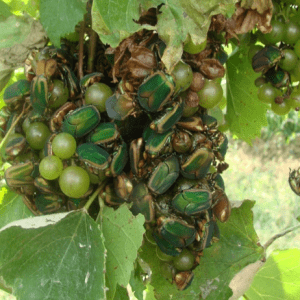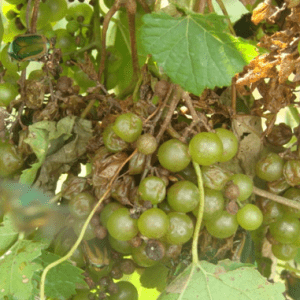Crop Production

Now is the time for fruit crop producers to scout for adult Green June beetle emergence. These beetles are considered a serious pest and can injure fruits of numerous crops including grapes, apple, pear, quince, plum, apricot, peach, nectarine, blackberry, and raspberry.
Adult beetles are attracted to the ripening grape clusters and fruits as the sugar content increases and fruit soften. Green June beetle populations fluctuate from year to year. The damage caused to fruit crops ranges from negligible in some years to considerable in other years. High population numbers of Green June beetles are often observed on maturing bunch grapes in Alabama (Figure 1).
- Figure 1. Green June beetles feeding on maturing Seyval Blanc grape berries.
- Figure 2. Green June beetle damage to grape clusters.
Identifying Green June Beetles
The adult Green June beetle is ¾ to 1 inch long and ½ inch wide. The color varies from dull brown with irregular stripes of green to a uniform velvet green. The margins of the body can range from light brown to orange yellow. The underside of the beetle is a metallic greenish or yellow.
The larva is a typical white grub, about 2 inches long when mature. The larva are easily distinguished by their habit of crawling on their backs. The larvae overwinter in the soil. Sandy soils high in humus or organic matter are preferred habitats. In the spring, Green June beetles tunnel near the surface. The beetles pupate in June. The adults emerge in July and August.
Beetles Cause Damage
Beetles gain entry into undamaged fruits by gouging with the horn on the front of the head, then feed on the flesh of the fruit. Several beetles may bury themselves entirely in a ripe peach. Their odor and excrement ruin most pieces of fruit they visit—even if feeding damage is not severe.
Completely dried up grape clusters are observed after Green June beetle feeding (Figure 2).
Refer to the Southern Region Small Fruit Consortium IPM Guide for control options.



